Please use the following link to download the February 20, 2021 issue of the syəcəb
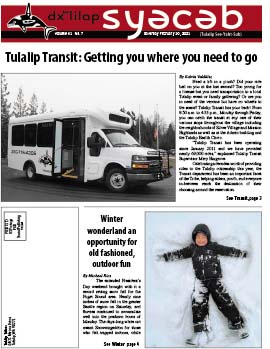
syəcəb
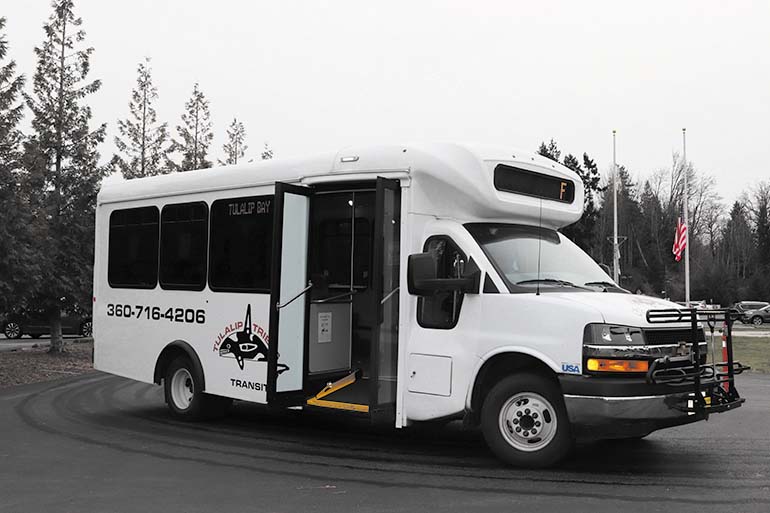
By Kalvin Valdillez, Tulalip News
Need a lift in a pinch? Did your ride bail on you at the last second? Too young for a license but you need transportation to a local Tulalip event or family gathering? Or are you in need of the vaccine but have no wheels to the scene? Tulalip Transit has your back! From 8:50 a.m. to 4:33 p.m., Monday through Friday, you can catch the transit at any one of their various stops throughout the village including the neighborhoods of Silver Village and Mission Highlands as well as at the Admin building and the Tulalip Health Clinic.
“Tulalip Transit has been operating since January 2011 and we have provided nearly 69,000 rides,” explained Tulalip Transit Supervisor Mary Hargrove.
Celebrating a decades-worth of providing rides to the Tulalip citizenship this year, the Transit department has been an important facet of the Tribe, helping elders, youth, and everyone in-between reach the destination of their choosing around the reservation.
“The Transit is public transportation, meaning it’s for everybody in the community,” Mary stated. “There’s only one route. It’s primarily in the Tulalip Bay area, and it circulates the main human services; the Administration building, Health Clinic, the Boys & Girls club, the gym, Family Services, beda?chelh.”
After nearly ten years in service, the two transit buses that are known throughout the community, with the blue and white tribal graphics, are getting a well-deserved rest with the introduction of a brand-spanking new bus that is loaded with features to accommodate the needs of the local populous.

“We have three buses total including the new bus,” Mary stated. “They’re called cutaways, or 12+2’s, seating twelve ambulatory passengers and two wheelchairs. We were trying for about five years for a new bus. When we finally got it, it was ready to be picked up right as we got the stay-at-home order. So, it didn’t actually get delivered to us until August. It took me a good length of time to get all of the protective equipment installed, and we started operating at the end of October.”
She continued, “The new bus features front boarding and seating for wheelchair passengers, destination signs, pull cord stop requests, onboard cameras, StabiliTrak system, Telma transmission retarder, and engine fire suppression system. 80% of the money came from a Federal Transit Administration (FTA) competitive grant opportunity. Everybody that has seen it loves it. Even people who aren’t getting on to ride; people driving about the community have actually stopped the driver to take a look at the bus.”
Lead Transit Operator Darlene Pittman, a driver for Tulalip Transit from the very start, is at the helm of the new bus, navigating the streets of Tulalip while also connecting with her riders on a personal level, learning each person’s first name and their story, upon entry to the bus. Darlene admitted her excitement for the new vehicle, stating the bus’s new toys have already come in handy.
“I haven’t had a rider that is in a wheelchair yet, but I have had people who are handicapped who needed to use the ramp,” Darlene stated. “The seatbelts strap in and we have these little black bags on the side by the wheelchair spaces, those are wheelchair tie-downs. They tie down at four points, so you don’t put any stress on it or break it if you stop suddenly. Another new feature that we didn’t have before, and I think people will really like, is the bike rack located at the front of the bus. I also have the marquee board up in the front and on the side, it says ‘Tulalip Bay’ and ‘Masks Required’. When I have to go get fuel, it will read ‘Out of Service’ and if there is an emergency on the bus and I don’t want somebody to know I’m calling 9-1-1, I can change the marquee board to flash ‘Emergency, call 9-1-1’.”
Initially, when the pandemic hit, the transit services came to a complete halt. But as months went by and more information was learned about the virus, the department was able to open operations, with a great amount of emphasis on safety for the driver and the rider alike. The Transit department took several precautions and set forth new rules to help limit the spread of the coronavirus. The department also received access to funding through the CARES Act, funding granted to help the Tribe withstand the global outbreak.
Said Mary, “The buses are equipped with a protective driver shield, sanitation supplies, reduced seating with availability to socially-distance, and we are requiring that masks be worn. All of this is for us to do everything we can to reduce the spread of COVID-19. I would also like to mention that the Centers for Disease Control (CDC) recommends that if you have COVID-19 to avoid public transportation, ride-sharing or taxis. Our driver is masked, the passengers are required to wear masks, we have signage posted on the bus, we disinfect the bus, and we have masks on board in the event somebody wants to board but doesn’t have a mask.”

Mary explained that the Transit adheres to a strict, set route but the driver is able to deviate from the route up to 3/4 of a mile, depending on the drivers schedule and if proper arrangements are made at least one day in advance.
“We have a fixed route but we also provide route deviation for registered passengers,” she stated. “We will do deviation upon request. We’re making efforts to provide more personalized services to the community. For instance, we had an elder who was at her friend’s house and she needed to get home. Her friend didn’t want her to walk down to the bus stop. The bus stop was just down the street from where she was, so we picked her up at her friend’s door and took her directly to her home. But like I mentioned, we can only deviate up to 3/4 of a mile off the route.”
The Tulalip Transit is currently running on a reduced schedule due to COVID-19, operating with one driver throughout the business week. The Transit does not offer services on the major holidays, so please keep that in mind when planning your travels. Please refer to their current schedule and the map provided to determine the closest bus stop in your area. For more information please visit their webpage at www.tulaliptribes-nsn.gov/Home/Community/ TulalipTransit.aspx or dial 360-716-4206.
Darlene reflected, “I’ve been here for eleven years and it’s exciting to see how we grew in everything that we do, and how we can make it better. I’m glad we finally got a new bus. The Tulalip Transit is important because what if you were stuck at home and needed to get to the Tulalip pharmacy but you didn’t drive, how would you get there? We’re here to serve the public and I think we’re hitting it on the mark pretty well. We just want to continue to let people know we’re here and we’d be happy to get them where they need to go.”
March 31, 1937 – February 5, 2021
Katherine Maryanne Monger of Tulalip WA went to be with our lord on Feb 5, 2021.
She was born March 31, 1937 in Auburn WA. She loved to travel with the 1910 shaker members and cedar circle. She was very traditional, would share her teachings with everybody that would listen every chance she could. She served on the enrollment committee for the Tulalip Tribes for years. She loved to travel with the seniors and enjoyed playing bingo and slots. She also enjoyed sewing, crocheting.
She loved cooking especially for special events at the Tulalip Amphitheatre, Boom City, kid’s fundraiser events for sports, family and spiritual functions.
Although she was a raider fan she supported our Seahawks and enjoyed game days with family.
She was proceeded in death by her husband of 47 years James (Jim) Monger Dad & Mom Robert & Ivy Guss, daughters Ivy Guss II & Ella Sanchez, Brother Alvin Charles, Grandsons Albert Power and John Gibson and son in law Robert Power. And her fur baby- baby.
She is survived by her favorite cousin Lillian (Baby) Gomez and family, daughter Elizabeth Monger Grandchildren Michael (Crystal) Monger, Chris (Heidi) Enick, Dakota (Darla) Monger, David and Andrew Enick, Robert (Lisa) Guss, Ivy and Selena Guss and Anthony Power, 27 great grandchildren 15 great great-grandchildren and numerous adopted kids and grandkids and extended family.
She touched many lives and will be greatly missed by all who knew her.
Viewing at Schafer-Shipman funeral home Wed Feb 10, 2021 8am-10:30 am
Burial to follow at Mission Beach Cemetery. Arrangements entrusted to Schaefer-Shipman Funeral Home.
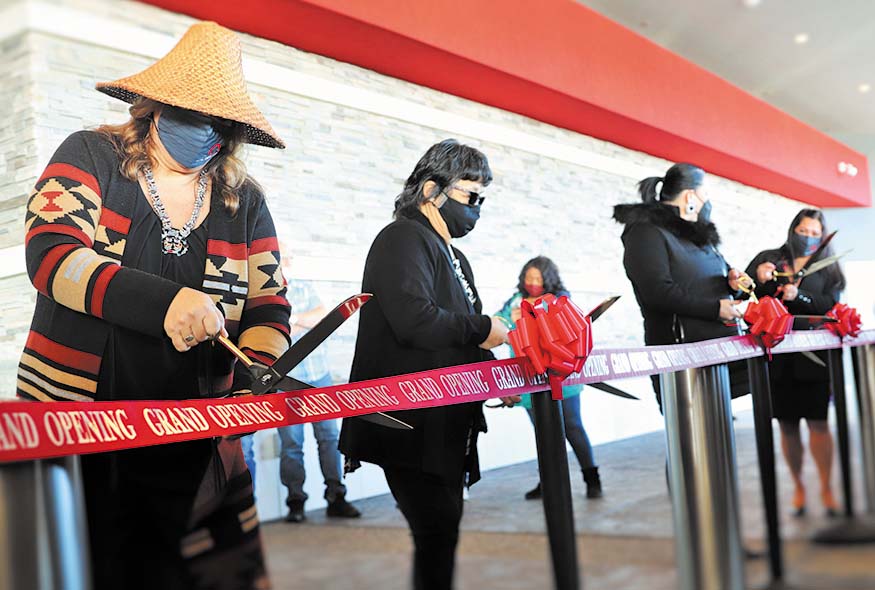
By Micheal Rios, Tulalip News
“What a beautiful day!” marveled Chairwoman Teri Gobin to hundreds of Tulalip citizens, elders, and anxiously awaiting gamblers who attended the new Quil Ceda Creek Casino’s grand opening on February 3.
“I’d like to thank everyone for being here today. This has been a long project. It’s been four years since we broke ground, but what an awesome finished product we have now,” she continued. “There really is so much more to love with this new facility.

“Tulalip’s gaming revenue funds our tribal government and tribal services, so for us and many other Native communities gaming is an essential business. Our gaming organization brings economic development to not only us, but to our surrounding communities and local businesses that benefit from our visitor overflow.”
The highly anticipated new casino spans 126,000 square feet – nearly twice the size of the property it replaced across the street. The new “Q” will spotlight a beautifully designed and greatly expanded main casino, a contemporary food hall and additional dining options, an innovative entertainment venue and a six-story parking garage. The $125 million casino and parking garage is situated on 15 acres of Tulalip land located directly off I-5 at exit 199.
Following a traditional Tulalip prayer and ceremonial blessing, each Tulalip Board of Director offered words of encouragement for the future and reflection for past leaders and ancestors whose vision and sacrifice made present day accomplishments possible.
“It’s been a long journey for Tulalip to get to where we are today,” said Board of Director Glen Gobin. “From our humble teachings to our humble beginnings to being an economic powerhouse in Snohomish County, we hope this continues to strengthen us as we go forward in a positive way and provide for the needs of our growing membership. We’ve got a lot to be thankful for.”
“I want to acknowledge everyone who participated in this project,” added Board of Director Marie Zackuse. “It was our ancestors and elders before us who had the vision to set aside land for their future generations. All [the success] of Quil Ceda Village and our casinos is thanks to them. We thank our ancestors for this opportunity and our elders who are here in attendance today to support us.”
The new “Q” features a radiant gaming floor with 1,500 gaming machines and 16 table games. Millions of high definition pixels span the walls for patrons to view rivalry weeks galore and competitive matchups across the sporting spectrum. A state of the line air filtration system combined with vaulted ceilings keeps the air fresh and atmosphere desirable. Just as it was previously, the new casino will operate as a 100% smoke-free, vape-free property.
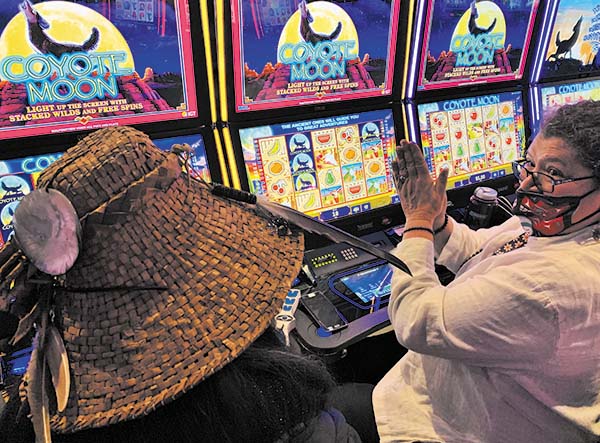
For thousands of Tulalip Reservation residents, the prospect of having more local dining options, especially top notch quality meals at reasonable prices, is the real jackpot. Inside the new “Q” is a food lover’s dream – a food hall dubbed The Kitchen offers seven cooked-to-order food venues. Menu items will spotlight fresh, local ingredients from Northwest suppliers prepared with the latest green cooking techniques. The Kitchen provides a tasty lineup including freshly prepared pizza and pasta, steaks, seafood, breakfast all-day, sandwiches/soups, global cuisine, frybread and more.
“I hope the Tulalip membership is proud of the new facility because this is our future,” said Belinda Hegnes, the Q’s interim executive VP. “I’ve had the opportunity for 28 years now to be a part of the Tulalip Gaming Organization family. We’ll continue to provide the friendly, casual guest experience we’re known for, but now in a larger casino with more room to enjoy all that we offer. We mean it when we say there will be more to love in gaming, dining and entertainment. More slots, more jackpots, more food venues, more fun, and more exciting times to celebrate as we move forward together.”

The Quil Ceda Creek Casino will continue to safeguard the health and safety of guests and team members with multiple programs: limited capacity, guests and team members are required to wear properly fitting masks, no-touch temperature checks performed upon entry, social distancing, aggressive deep cleaning procedures, and entertainment areas closed based on COVID-19 guidelines. For more information on sanitation, health and safety measures visit the casino’s website: www.quilcedacreekcasino.com
By Kalvin Valdillez, Tulalip News
Last month, when the collective known as the Maternal Child Health Committee (MCHC) formally introduced themselves to the community via Tulalip News, the people showed a great amount of interest for the new committee and the possibilities it offers their families. Comprised of Family Haven, TELA, Community Health and beda?chelh, the group of Tulalip programs aims to provide assistance, education and resources to expectant mothers and young families by uniting as one.
“Our goal is to bring together all the different departments within the tribe, that serve families with children under five, to provide information that will be helpful to the community as well as resources that might help families out,” said Family Haven Manager, Alison Bowen. “Each department complements each other and we’re able to look at the child and the family in a really global or holistic way.”
The committee meets regularly, brainstorming ideas for upcoming classes and activities, as well as discussing how to reach more mothers and young families who can utilize their services. Each month, MCHC will host an online Zoom class for the Tulalip community where participants can interact with other parents, learn new skills, ask any questions and win prizes. The departments will alternate hosting duties every month and each lesson will focus on a new topic, which that month’s respective department specializes in. Now officially underway, MCHC is gearing up for their very first Zoom lesson on February 18, which will be led by Family Haven.
“We will be teaching from the Family Spirit curriculum, from Johns Hopkins Center for American Indian Health,” said Sasha Smith, Family Haven’s Family and Youth Support Coordinator. “We’re going to teach from our Infant Care section, which is called ‘how to protect’. We are going to teach three main subjects. How to protect yourself, that focuses on blocked airways and poisonings; all about falls, infants experiencing fall related injuries; and burns. And we’ll be going over water safety.”
Sasha explained that the Family Spirit curriculum promotes the health and wellbeing of young families. The program is known nationally for its culturally-relevant and community-based approach to maternal health and early childhood development. The Family Spirit model was created and based off of years of research conducted by the Johns Hopkins University.
Thanks to Family Haven’s involvement with MCHC, those who attend the first Zoom lesson of the year will get the first-glance at the Family Spirit curriculum and hopefully learn a few new tips, tricks and skills to try at home. As Sasha stated, the class will focus on three subjects regarding infant safety, specifically choking, falling and burns. When asked if these are common issues that mothers and families face, she replied that they are indeed and that the upcoming online lesson will provide tips on how to avoid those types of accidents.
Sasha stated that the lesson is full of reminders that urge parents to pay a little more attention to the things they may not think often about, such as the temperature settings of your water heater. She explained that since many people in the community deal with Tribal housing, you can request that they come out and check and/or adjust your water heater temp, in order to avoid accidentally using scolding hot water on you and your baby. She also indicated that the lessons are tailored to the Indigenous community and features illustrated characters who are of Native American complexion, an important detail so young Native parents can see themselves in the lessons throughout the curriculum.
She said, “I think that there are some things that we all tend to overlook. We forget about those simple things like checking the water before you put your child in the tub or thinking that because they’re only six months old, and they’re still in their car seat, you can set them up on the table and they’ll be fine. Most parents know a lot of this stuff already, but it’s a good reminder to reinforce those habits of checking your surroundings, making sure things are picked up off the floor and not setting down or allowing your child to climb up on the table.”
MCHC plans on hosting in-person classes as soon as it is possible and safe to do so during the era of the coronavirus. For now, they have arrangements extending into the summer months for more fun, online interactive lessons. TELA is up next in March and they will teach a lesson on early childhood development. Be sure to stay tuned to Tulalip News for more details.
For those who are unable to attend the first MCHC Zoom lesson, Sasha wants to provide a link to a free, online First Aid & CPR training, https://www.southsnofire.org/education/a-c-t-first-aid-class, as well as the number for the Nationwide Poison Control Center, 1-800-222-1222, just in case.
The first MCHC Zoom lesson is taking place on Thursday 2/18 at 3:00 p.m. If you wish to attend, please contact Family Haven for more details or simply follow this Zoom link on the date and time listed above. https://zoom.us/j/92147697876?pwd=b0hPK0psN05Fem9DMzZRbzBGNjZ5Zz09
“I think this is all important and a great way for the larger community to learn some new information,” expressed Alison. “As parents, we learn more based on new information that is constantly coming out. At one point in time, a lot of people thought it was perfectly fine to feed your kids hotdogs, and hotdogs are now known as one of the top choking hazards for children. You would think that it is safe and healthy feeding them lots of fruits and vegetables, but foods like grapes are an easy thing to choke on. So yes, there are things that are considered common knowledge that we kind of forget about and need reminding of, but a lot of this is also based on new information, new studies and statistics – how we should start doing things a little different for the future generations.”
By Kalvin Valdillez, Tulalip News; photos courtesy of Walter Moses
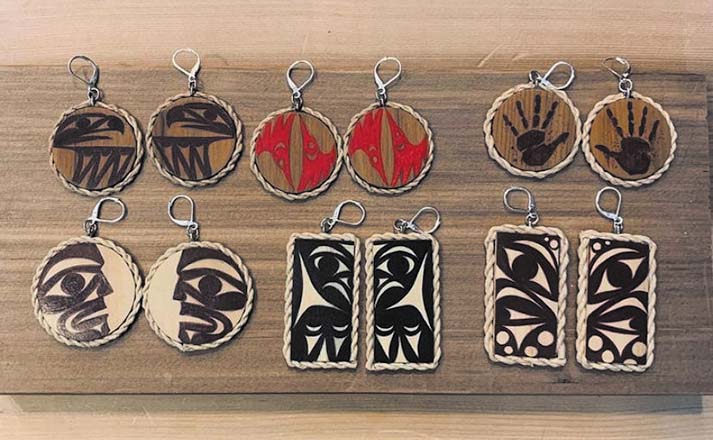
“Cedar is a sacred tree to the Tulalip Tribes, there are numerous stories behind the cedar tree,” said Tulalip Artist, Walter Moses. “I’ve been in the lumber industry for a decade and I’ve seen and worked with all types of cedar and learned a lot of history behind the cedar tree. Every piece has a specific grain to it, all the grain is not going to be the same. Some of them will have different shapes and different lines. To me, that piece of cedar is actually telling a story. Sometimes you’ll see little waves inside the cedar. At that time in the tree’s life, there was a lot of turbulence and a lot of stress on the tree. When you see someone wearing a pair of my earrings, they’re actually wearing something that came out of a 200, 300-year-old tree, a tree that has been here longer than the country itself. What they’re wearing is a piece of history.”
Long before colonists arrived to this sacred land, the Indigenous people of the Northwest took great care of the region, living and thriving off the land’s natural resources. As Walter stated, the cedar tree played a significant role in the lifeways of the Salish people. The cedar was used for a number of means in all aspects of our ancestors’ everyday lives. Some traditional items created from cedar include bentwood boxes, paddles, rattles, totem poles, baskets, hats, masks, headbands and canoes. Whether it was for fishing, hunting, gathering, ceremonial, medicinal or spiritual purposes, the cedar tree could be fashioned into a number of tools by way of weaving or carving techniques, teachings that have been passed on generation after generation.
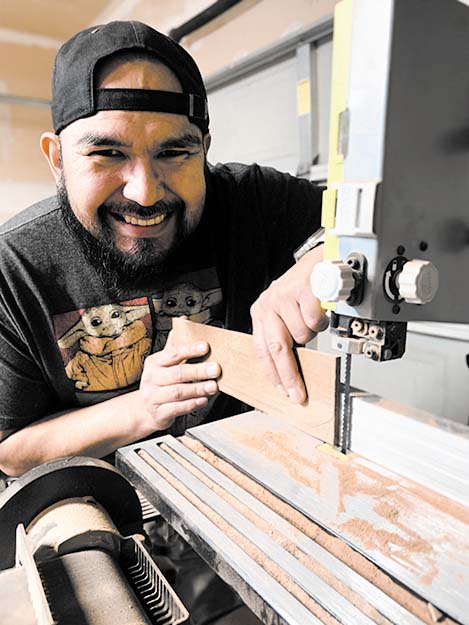
“My dad is a carver and his father was a carver, it just runs in the family,” Walter proudly expressed. “As far as I can remember, my dad’s always been carving stuff like masks, paddles, totem poles, just a large variety of traditional things. When I was about 11 years of age, he sat me down to teach me how to carve, how to use an adze and the simple techniques that we use in carving. My first project was a shovel-nosed canoe, that’s a traditional mountain canoe, not like the sea-going ones that you see on the canoe journey. It’s the ones our people used to go up and down the rivers in the mountains, and they look quite different than the ones you see out on the Puget Sound, they have thicker hulls and are in the shovel shape. I still remember the lady who bought it from me, she bought it for $40 and I spent the money at the Marysville Strawberry Festival.”
Walter is quick to point out that his personal journey with art, however, did not begin with carvings. Although he observed his father and Tulalip Master Carver, Kelly Moses Sr., perfect his craft from a young age, Walter initially fell in love with drawing, often sketching scenic pictures, animals and whales. He was encouraged daily by his father and teachers. His art was showcased at the front of his classrooms at school and he also received ‘A++’ reviews from Kelly Sr. on the regular.
Walter said, “I actually started drawing when I was about 5. As far as I can remember, I’ve always been drawing. Drawing is one of the main fundamental skills that I had to master in order to become a carver. There are multiple skills when it comes to carving, that isn’t carving itself. You’re talking about blueprinting everything out; you have to be a good drawer, you have to be able to look at something and draw it down. You have to know the cedar type, the grain, how to get the cedar. So, it’s not just carving, there’s a story and you have to know how to tell those stories. There’s a multitude of things you have to learn over time.”
Historically, carvings are integral to traditional ceremonies. Songs, dances and stories are shared utilizing cedar carvings; singers shake rattles, dancers pull paddles and stories are commonly re-enacted with masks. Today, Walter took that knowledge from generations prior and found a way to honor the traditional art of carving and blend it with his own unique style, creating modern day jewelry such as bracelets, pendants and his highly popular and extremely limited earrings.
“Nowadays I’m creating a lot of jewelry which would include earrings, pendants, bracelets, and I can still do some masks and paddles,” he said. “The reason I’m doing earrings and pendants is because masks and paddles are something for the home, something to showcase on the wall when guests come over. With jewelry, it’s art you can take with you. It’s a piece of history that you’re taking with you, that you can adorn your body with because the spirit lives in the body, so why not adorn the spirit with a piece of history.”
For two-years, the full-time family man and lumberman dedicated his weekends to his passion. He explained that the decision to follow this journey just may have been his destiny as his grandfather, on his mother’s side, also handcrafted jewelry, specializing in beaded necklaces.
Walter originally stumbled across jewelry-making while raffling paddles and masks at local Indigenous gatherings. When he noticed the majority of people who purchased his raffle tickets were women, he began to take requests, one of which happened to be for earrings. Walter accepted the challenge and upon seeing the positive response after posting his first set of earrings online, he decided to pursue this path and dedicated his time and energy to making jewelry and regalia crafted from cedar.
“It’s just a natural thing,” he said. “I think about art like all the time. At work I’m thinking about art. If I see a certain shape on a piece of wood, I go wow that would make a really cool piece of art. My dad helped me develop a photographic memory. If I see something awesome, I build off that. I have an art disease in my brain that causes me to think about art all the time.”
Through his artwork, he still gets the opportunity to express his love for drawing, incorporating formline by hand-painting and micro-engraving Indigenous designs into many of his earrings. And because each piece is hand carved and painted, the earrings are in high-demand and extremely limited, often selling minutes after Walter adds them to his social medias. It is also very important to him that he does not replicate any of his past work, that each new pair of earrings, pendent or bracelet is an original one-of-one creation. Walter also incorporates modern-day meme-culture into his artwork, recently creating Baby Yoda and Bernie Sanders earrings which were a huge hit on his Instagram profile.
Walter explained, “I’ll look at something and think, ‘hmm, I can make something out of that’. I use a lot of rulers, rulers are very important. Fractions are also very important for measuring the wood, making sure each piece is measured and the thickness is correct. I’ll go from there and just build. I don’t blueprint, I just make them up as I go along. For my masks I’ll do a blueprint, but for the earrings I do the first design that comes to me. Even though there is a lot fine detail that goes into them, I’ll leave defects in there just because it shows the human spirit in it. You know, not everything is perfectly identical, it’s unique in its own way. Sometimes I’ll leave little scratches or dings on there because it adds character to it, its own uniqueness.”
Walter also does his part in sharing the knowledge of his craft, prepping the next generation of Tulalip artists, not only by involving his own kids in his work, but also by teaching classes at Tulalip-Heritage High School as well as sharing stories at a handful of elementary classrooms in the Bellingham School District.
“Last year, before COVID broke out, one of the Native liaisons reached out to me and asked if I was interested in teaching at Tulalip-Heritage. I used to go out there twice a month and teach them how to carve, how to make earrings and about our art in general, just to get them involved and get their hands moving,” he said. “My dad always told me to keep your hands busy all the time. That’s a lesson that I teach and practice. I also talk at the elementary classes in Bellingham, telling them some of our stories. I speak in front of the class for about an hour, a lot of its been online though, not in person. When we pick back up, I’ll actually share in-person. Kids should know the history of the people in this area and not think of us just as people who own casinos and live on the reservation. They should know we have a unique background, that there were people here before their ancestors came and that we’re still here and will always be here.”
Walter is proudly continuing in the footsteps of his bloodline, building upon what his father and ancestors passed on through the generations and continuing the Moses legacy of carving. And it appears as though his journey is just getting started as word about his work continues to spread across the social media platforms.
“My work is not just a piece of wood with a Coast Salish design on it, it’s also a piece of me – a bit of my teachings from my father and his father, a bit of my meditation, prayers and good-thoughts. My dad taught me that as sduhubš people, we all have a special gift, something that we are meant to do to help our people out,” he shared. “And the younger people might not know what it is yet, but they will find their way to help our people. Our special gift is something that we get from our maker. Not everyone is going to be a carver, storyteller, leader, spiritual worker, everybody has their own special gift that will help them. Mine has helped me through some tough times growing up. When I was younger, I knew that I could always fall back and count on my art to help me out.”
A gallery of Walter’s carvings can be viewed on his personal Instagram account, @WalterM2213. Walter also does special requests on a case-by-case basis, depending on his time available. Be sure to send him a direct message if you are interested in purchasing any of his handmade cedar jewelry.
“It’s important for me to carry this on because it’s a part of us, part of my family. I don’t really even consider it my art, I consider it our art. I carry it on because it’s a statement that we’re still here. I read somewhere that the revolution will come in the form of contemporary art. I like how that sounds, so I continue to do it.”